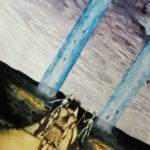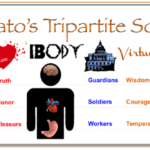Aristotle’s De Anima Book II
Chapter 1 – The Definition of Soul – Cause to Effect
In this first chapter, Aristotle claims matter and form correspond to body and soul, because a living thing is a natural body that exhibits the characteristics of sense and nutrition. Like all natural bodies, there is not only one way we can say they “are,” there are ten. So just like dirt has characteristics which don’t make it what it is (e.g. color), so too living substances have acts which don’t make it what it is – like actualizing knowledge. Having the knowledge to be actualized as habit, however, is like the first act – its necessary for the second.
Just like the habit of knowledge is necessary to be able to actualize the knowledge, so to the act of being a substance on matter (the act of a body having life potentially within it) is necessary to have any other qualifications of “this living thing.” When we consider that all living things have the characteristic of having parts that are used for the whole (e.g. leaves for shelter – organs) we notice that the soul “actualizes those organs as matter for the whole- thus, we get the final definition: the first act of a natural “organ” – ized body.
Last, he distinguishes different senses of part in the whole. If an axe was a natural substance it would chop on its own, as an organ. But since it doesn’t, the difference must be a substantial form that unites the matter towards an end. This is why an eye doesn’t have a purpose apart from sight, and sight doesn’t have a purpose apart from a seer. Without the soul (seer) the eye is no more an eye than that of one in a statue.
- Aristotle points out that there are in natural bodies matter (potentiality) and form (actuality). Form, or act, has two senses however – substantial and accidental:
- First act is like knowledge (corresponds to actually existing), and so also corresponds to the actuality of a body in potential to have life
- Second like the exercise of knowledge (doing something with your existence (movement/operation).
- Some natural bodies have unique acts: self nutrition and growth (acts which are the signs of life). Those things which are moved from the outside are called inanimate.
- Following this distinction, Aristotle identifies the soul as the first grade of actuality of a natural body having life potentially within it.
- Since this body has parts (Plants’ leaves are like shelter and roots are analogous to mouths – they serve as organs – organized. This is a definition of by way of example.) then we can modify the definition to the first grade of actuality of a natural organized body. Just like its meaningless to ask whether the wax and the shape given it are one, so its meaningless to ask whether the soul and the body are one: unity has as many senses as the categories
- This is the definition he goes on to explain in greater depth.
- He uses an analogy with an axe to demonstrate what he means by an organ. If we imagine that an axe were a natural form (with its movement towards the end of cutting being intrinsic to it, it would chop on its own. But it does not have a soul and so it if is an organ/instrument, it is an organ of the lumberjack. This is how the eye is to the soul – it has no power to see on its own, even though the form as a whole depends on it for sight, just as form depends on matter. Without the soul, it is as much an eye as the eye of a statue.
- *”…potentially capable of living” is not the matter that lost its form (because matter doesn’t exist apart from form) but rather only what still retains it (seeds are the exception). Thus the pupil plus the power of sight (end) constitutes the eye, so the soul plus he body constitutes the animal. (perfect contains the imperfect*)
- Since matter is inseparable from form, it follows that the soul is inseparable from the body – or at least that certain powers of the soul are inseparable from the body, since the actuality of some of them is nothing but the actuality of their bodily parts. Some other powers are separable, because they are not the actuality of bodies at all (flesh for example or something).
In summary, Aristotle lays out his definition of soul and how the parts/organs relate to it and their powers.
Chapter 2 – Defining the Soul – Effect to Cause
Most people historically when trying to define the soul, asserted their definition as if it were truth – like he just did, but provided no facts to back it up – this is like providing the conclusion without the premises that got you there.
Bodies with soul differ from those without in that they display life characteristics: thinking, sensation, local movement, or nutrition.
- Plants are living because they grow as long as they can absorb nutriment to a certain level.
- Animals posses local movement, some don’t, but all have sensation.
- Just as the power of self nutrition can be isolated from touch and sensation, touch can be isolated from sensation as its prime instance.
- The soul is the source of these phenomena (cause) and characterised by them (effects which we know first).
Are these parts distinguished in definition only or in situation as well? (in the first chapter he gave the apriori definition, now he’s going to give the reason for the teleology). This is sometimes easy and sometimes hard (like in the case of imperfect animals like certain worms).
And what about thinking? If opining and perception are distinct, then the power to opine and the power to perceive must also be distinct.
Some animals possess all these souls, while others possess only one. The same is true with types of senses. (Perfect contains the imperfect*)
Since the expression “That by which we live and perceive (sense and grow) can have two meanings: 1) the power of thinking and 2) the soul that is actually thinking, and since these two meanings relate to matter (power) and form (act), then that by which we live and perceive (sense and grow) relates to matter and form in a corresponding way: that by which we primarily act is form, and that which we have the power to actualize relates to matter.
Main point: Thus, since bodies do not manifest sensation and vegetation as bodies, and since that by which a thing (or body) primarily acts is what determines the kind of being (body) it is, then bodies do not live qua body – they require soul.
Chapter 3 – Moving from Definition to Species Intimae
Plants only have the nutritive, animals have the appetitive (orexis) which is the genus of desire (epithumos), passion (thumos), wish (boulesis)
So since its unreasonable to either expect to give a absolutely general definition or to define separately each species intimae, and since each higher power contains the lower (all sensing animals have nutrition, and all which sense have at least touch 415a), it is best to subsume each particular case under the common name “living being” and add what it potentially contains in the definition.
This chapter is not very heavy. The basic point is the third paragraph of Physics I.1 – we move toward the individual essence after we have the essential/formal definition.
Chapter 4 – Reproduction and Nutrition
In order to give the best definition of each particular thing then, we must start with a definition expressing what it is (species intimae?) and then investigate its derivative properties like thought, sensing and nutrition. But to do that, we must understand what acts of thinking, sensing, nutrition are. But to do that we must go further back and understand their objects: intelligible, the perceptible, and food.
The first of these to investigate is the proper to vegetative life: reproduction and nutrition. All life forms that eat also reproduce, since it is the most natural thing to it – the sake for which they eat: either a) the end to achieve (reproduction) or b) the being in whose interest the act is done (organ) – to produce again one like their own. Since the individual being can’t live forever, it can try through its offspring – the only means available to it, and the offspring remain not numerically one but specifically one. (*But why does it have an end beyond its own substance, Aristotle?! That seems selfless)
The soul is the cause of the body in all three senses that it is used: 1) the origin of movement (atom), 2) the end (liver), 3) the essence of the whole living body (DNA). (*these are three ways the thing can be united – cite in conclusion). Essence: The actuality of whatever is in potential is identical with its essence. Thus it is the movement toward the end “to live.”*End: This is that for the sake of which things are done in the order of nature and becoming – all natural bodies are organs for the soul. He reminds us of the two senses of end: 1) the end to achieve, order of perfection and 2) the substance in whose interest anything is done – the order of nature/becoming.* Movement: The soul is the cause of local movement, quality and quantity change. For nothing grows or decays naturally except what feeds itself, and nothing feeds itself except what has a share of soul in it.
Empedocles tried to explain soul in terms of the motion of the elements. But trees would grow to any size if there were not an essence.
Aristotle says nutrition and reproduction are due do one and the same psychic power. But there has always been a question of whether the benefit of food results from it being composed of elements contrary to our nature or like our nature. Aristotle thinks its neither because: food as undigested matter is contrary to the animal fed by it. So it depends which sense of food.
Only what is alive is fed, and so it is essentially related to soul. But the food becoming part of man is not the generation of the individual but rather an assimilation into the substance/maintenance.*.
The nutritive psychic power could be described as that which tends to maintain whatever has this power in it – which food helps. (*DNA does not have this). what is fed=the body which has soul; that wherewith it is fed=food; what does the feeing=the soul. The important thing is that the food does not do the action… the being must be capable of digesting it.
In summary of chapter 4, he explains that the soul is essentially, teleologically (in two senses), and modally the cause of the body as a substance. It even seems that the living substance has an end that transcends itself, because it does not reproduce for its own sake, but for the sake of the species. This power belongs to all life forms. Second, the nutritive power implies being able to assimilate food. Food does not generate man because it is the nutritive power that make it become part of the soul.
Chapter 5 – Sensation – Two Senses of Act and Potency
Sensation depends on a change or motion from without (external senses – goes into more detail in gen. and corr.). Problem: why do we not sense the senses themselves, along with the object, since both of them contain the elements. Previous thinkers through senses are like the elements they sense., but…
The external senses are sensitive potentially, not actually, because they need a soul to set them ablaze (like gasoline is potentially combustible, not actually – since it would spontaneously ignite). We use the term “perceive” ( ) in two ways: 1) in the sense that we have the power, passively like when we are asleep and 2) actually like when we are actually seeing or hearing. Then the same is true of perceiving (ὁμοίως – resembling): to potentially resemble or actually resemble/become like/habit.
Since everything that is moved is acted upon, or moved by an agent actually at work, then what acts and what is acted upon are like in one sense (after the movement) and unlike in another (before and during the sensation/movement).417a20
This requires that a final distinction be made in living things. Up until now we have been talking about the difference between potentially having sensation and actually having sensation to represent matter and form, but this is not exhaustive if we include the category of quality. A thing may move from potentially sensing to actually sensing (habitually/qualitatively), and a thing may move from actually sensing (habitually/qualitatively) to actually exercising that sense in an operation. Thus there are two contraries between which one might move and so two senses of potency and two senses of act. Wise men aren’t altered by using their knowledge/sense.
The object of knowledge is a universal which the man already has within himself. The object of sensation is what is outside himself…the particular. This is why a man is able to operate is thinking any time he wishes but has no choice about when he senses: the object of sense cannot be ignored, while the object of the mind can be.
The two senses of act and potency are most important and they have no names but, the perceiver is potentially like what it actually perceives – by assimilating the other and adding it as a quality. The knower becomes like, in quality, the thing known.
To summarize chapter 5 then – the problem posed was why do we not sense the senses themselves along with the thing sensed? He answered this by adding a third type of activity: operation which comes from actually having the quality of knowing, and actually having the quality of knowing is the actualization of the potency to know at all. So there are two contraries, and since the movement toward the thing perceived changes in quality the perceiver, and since the quality of the perceiver also changes what is perceived, then movement toward the thing perceived changes what is perceived. For example, as your hand becomes more hot you can’t sense the heat as well – also when you gain habitual knowledge, its hard to tell that you have it unless you actually reflect on having it. You slowly become like the thing known. (This is also a good reason to be careful what you watch and listen to.)
Chapter 6 – Proper and Common Sensibles
There are two senses of the sensed object: 1) what is perceptible by a single sense – the proper sensible and 2) what is perceptible by any and all of the senses: the five. Each has one type of object that it discerns and never errs in reporting that, though the judgment following it may be erroneous.
Common sensibles are movement, rest, number, figure, magnitude. These are kinds of movement that are perceptible by touch and by sight.
The fact that the white perceived is the what of the cloak of the king is incidental with respect to the sense. This doesn’t affect the senses.
In sum, the proper senses are the well known 5 senses which never err in recognizing their objects, and the common sense is not well known (in his meaning) because it unites the senses and allows us to see change in the broad sense: motion and rest (localmotion), shape, size, and quantity.
Chapter 7 – Sense of Sight
Sense Contrary:
Object Contrary: Visible vs. Invisible
Formal Definition
Material Definition
Sight can refer to a) the color (actual sight) or b) the thing which can be described in words but has no name yet (potential sight). Sight properly refers to the color, since color lies on the surface of what is in its own nature visible. Visibility doesn’t mean it is involved in the definition, but that the matter contains what causes visibility.
“Essential” can be said in two ways: 1) when the predicate is a sort of cause of the subject (nose is snub), or when the subject is a sort of cause of the predicate (man is animal). It is the in first sense that color exists i.e. color comes from matter – a quality, not from form.
Light is the proper color of what is transparent, and is the presence of fire or something resembling fire (radiation) in what is transparent. He claims Empedocles was wrong to think light travels, but he doesn’t think so because, if the distance traversed were short, the movement might have been unobservable, but where the distance is from extreme east to extreme west, the draught upon our powers of belief is too great. (Not quite sure what that means)
Color is the power to set into movement what is already actually transparent, and the actuality of what is transparent is light. If the object of sound (air) or smell (no name) is in immediate contact with the organ, then no sensation is produced either. There has to be a medium diaphorus. This also even applies to touch or taste. The medium for sound is air, the medium for smell has no name, the medium for sight is the transparent. Color sets in motion not the sense organ, but what is transparent.
Chapter 8 – Sound
Sense Contrary: Power of setting
Object Contrary: Sound vs. Soundless
Formal Definition: two bodies and a space between them – and some impact of a body – just like light is always reflected so sound is.
Material Definition
Sound can mean actual or potential sound.
- Actual sound requires two bodies and a space between them – and some impact of a body – just like light is always reflected so sound is. Things that are smooth and solid tend to have a sound, and things that are not smooth but like cloth or wool absorb it. Its probable that all sound produces an echo even if we don’t notice it.
- Potential sound belongs to whatever can set in movement a single mass of air which is continuous from the impinging body up to the organ of hearing, which has something of air in it.
Formal Definition: Voice is a kind of sound characteristic of what has soul in it; nothing that is without soul utters voice.
Material Definition: Voice then, is the impact of the inbreathed air against the windpipe and the agent that produces the impact is the soul resident in these parts of the body.
In summary, for the senses to operate, there must be the organ, the body it senses, and a medium: something transparent for sight, air for hearing, no name for smell.
Chapter 9 – Smell
Sense Contrary:
Object Contrary
Formal Definition
Material Definition
Chapter 10 – Taste
Sense Contrary:
Object Contrary:
Formal Definition
Material Definition
Chapter 11 – Touch
Sense Contrary:
Object Contrary: Tangible vs. Intangible
Formal Definition:
Material Definition
Definition of Sense: Has the power of receiving into itself the sensible forms of things without matter – its proper object. It has an incidental object as well. The sense and the organ are the same materially, but different formally. The organ perceives and the sense perceive. But the sense power is not a spacial magnitude not is the sensation – they are a power in a magnitude.
In summary then of book II, Aristotle gave material and formal definitions of the soul, reproduction and nutrition, sight, sound, smell, taste, and touch. The formal definition gives subject without presuming that it actually exists, while the material gives it existing as though already formed.




